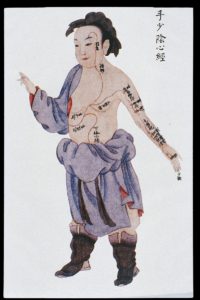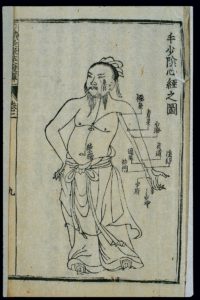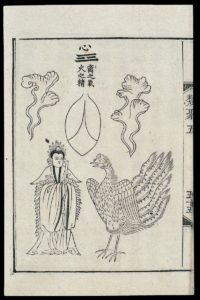Here is the Fourth Point of the Heart Channel – Líng Dào – Spirit Pathway (HE-4) from the upcoming translation of Explanations of Channels and Points, translated by Michael Brown and edited by Allen Tsaur, published by Purple Cloud Press. This work may not reflect the final edition.
The Fourth Point of the Heart Channel
Líng Dào – Spirit Pathway (HE-4)
心經第四靈道

穴在掌後一寸五分,手少陰心脈所行爲經金。《銅人》:鍼三分,灸三壯。
This point is located 1 cùn and 5 fēn behind palm. The hand shàoyīn heart vessel flows here, as the river and metal [point]. The Tóngrén states “needle 3 fēn, moxa 3 cones”.
注:心主神靈,此穴爲心經所行,故曰靈道,走而不守也。
Explanation: the heart governs the spirits[1], this point is where the heart channel travels, therefore it is called Líng Dào (Spirit Pathway), as it moves and does not guard[2].
心之心病:心痛乾嘔,悲恐,相引瘈瘲,肘攣,暴瘖不能言。
Heart diseases of the heart: heart pain with dry retching, sorrow and fear, alternating tugging and slackening[3], hypertonicity of the elbow, sudden loss of voice with inability to speak.

注:心痛而乾嘔,乃心氣之逆也,悲恐乃心氣之虛也,相引瘈瘲,心爲一身神明之主,而邪乘之,故有是症,
Explanation: heart pain leading to dry retching is a result of the counterflow of heart qì. Sorrow and fear are due to the deficiency of heart qì. For alternating tugging and slackening, the heart governs the bright spirit of the entire body, when an evil overwhelms it, then there are these signs.
肘攣乃本經所行之部分也,暴瘖不能言,乃心氣不至於舌也。以上症皆心經所行部分,責之以通其滯。
For hypertonicity of the elbow, this is the area where this channel travels. Sudden loss of voice with inability to speak is a result of the heart qì not arriving at the tongue. The above signs are all areas where the heart the channel travels, seek this [point] in order to free the stagnation.

[1] This is the two terms神 Shén and靈 Líng together. For the distinction between the two types of spirit, please refer to the explanation in HE-2.
[2] This is a common phrase in herbal treatment. The Practical Dictionary notes that this phrase describes the mobile nature of the medicinals, that tend to cause movement.
[3] Alternating tugging and slackening 相引瘈瘲 may be similar to the condition of clonic convulsions.
Images courtesy of The Wellcome Collection.
